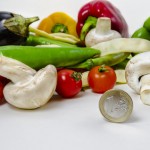This delicious vegetarian curry is so simple to make and tastes amazing over basmati rice or served with some delicious plain naan bread. Fantastic for your 5-a-day and you can vary the vegetables to whatever you have available.
Top with some fresh coriander for a professional finish.
Skills Check
Follow a recipe; follow food safety & hygiene rules; tidy away; use a measuring jug to measure liquid; use measuring spoons; chop using bridge/claw technique safely; use a vegetable peeler safely; crush garlic; use the hob (with adult supervision); season to taste.
Allergens
None
Equipment
Measuring jug, measuring spoons, knife, chopping board, vegetable peeler, large saucepan, wooden spoon, scales, garlic crusher.
Ingredients (serves 4):
- 2 tbsp vegetable oil
- 1 small onion, chopped
- 2 cloves garlic, crushed
- 2 tbsp curry powder
- 225g carrots, peeled and sliced
- 225g mushrooms, quartered
- 1 small head of cauliflower, broken into florets
- 2 tbsp tomato puree
- 225g tin of chopped tomatoes
- 600ml of vegetable stock
- 410g tin of chick peas, drained and rinsed
- 100g frozen peas
Method
- Heat the oil in a large saucepan and gently fry the onion for 2 minutes. Add the garlic and curry powder and stir, making sure to coat the onions and garlic in the powder. Leave to cook for 2 minutes
- Stir in the carrots, mushrooms and cauliflower and gently fry for 3 minutes more.
- Add the tomato puree, tinned tomatoes and stock, bring to the boil and stir in the chick peas.
- Leave to simmer gently for 10 minutes then stir in the peas.
- Cook for a further 10 minutes, season to taste and serve.
So thinking about chickpea and vegetable curry ...

Vegetables are so good for us! Low in fat, sugar and calories and high in vitamins and minerals.
Nutritional Information
| - | Energy | 1182k J/ 282kcal | 14% |
| Low | Fat | 10.1g | 14% |
| Low | Saturates | 1.2g | 6% |
| Low | Sugar | 9.7g | 11% |
| Low | Salt | 1.1g | 19% |
per 450g serving
% of an adult's reference intake
Typical values per 100g: Energy 263kJ / 63kcal
Notes
A traffic light system is used on nutrition labels to make it easier to see which foods and drinks are lower in calories, fat, sugar and salt. Try and choose more ‘greens’ and ‘ambers’ and fewer ‘reds’, and stick to smaller portions of ‘reds’.
Just because a recipe or a food has a red traffic light doesn't mean you shouldn't eat it. Understanding why a food or recipe might have a red light can be helpful. For example oily fish is high in total fat and so any recipe containing oily fish is likely to be ‘red’ for fat. But it is recommended that we eat oily fish at least once a week because the type of fat it contains is beneficial for our health.
% Reference Intakes are also shown. Reference Intakes are guidelines about the approximate amount of particular nutrients and energy required for a healthy diet (based on an average-sized woman doing an average amount of physical activity). Most children will require less than these Reference Intakes. The contribution of one serving of a food or drink to the Reference Intake for each nutrient is expressed as a percentage.




